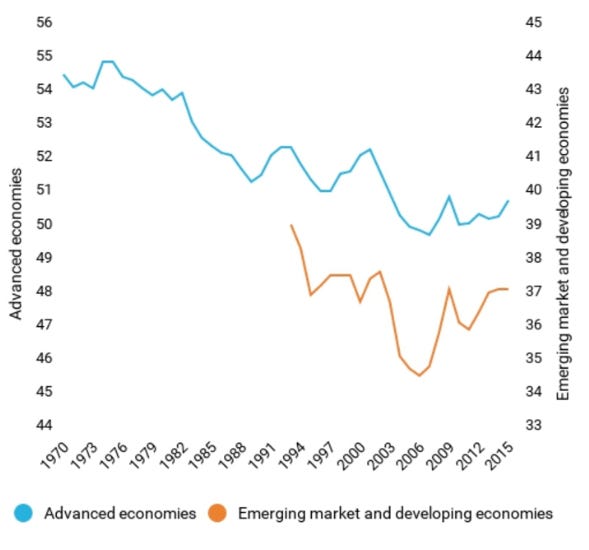This issue on the future of work is 700 words long and it takes ~2.5 minutes to read. I hope you enjoy it.
The transition from ownership-based products to on-demand services is a trend that seems to be growing. Continuity of ownership incentivizes companies to design reliable and repairable products which maintain their value for longer than consumer products. In simple terms - if the company owns the product, it has strong incentives to make it work better and for longer. If, on the other hand a company is in the business of selling products, it’s incentives are realigned. In order to keep growing the company needs to keep selling. This means that typically companies that sell consumer products will organize iterations around (planned) obsolescence in generating demand for future products. Some countries have moved beyond the easy pickings of the service economy with Uber and AirBnB being the brand names of the first decade of the on-demand economy. International companies are addressing various niches; Netherlands based bundles.nl provides an on-demand service model for coffee-makers, dishwashers, washing machines and even mattresses.
During the strong growth of the 1990s there was a shortage of low-skilled labor that made even fast-food restaurants pay signing bonuses. In our mobile and interconnected world that paradigm has changed. The global economy has been shifting away from manufacturing and towards services for the past thirty years. The impact to the typologies of work in the labor market have been difficult and have had serious consequences to social and economic inequality. While the manufacturing economy provided a stable route to the middle class, the current services economy is sharply fractured between low-paid service workers and the high-paid creative class. The Taylorist paradigm cannot work in this new context. Automation alters the character of work, changing not just the skills but also the attitudes and roles of workers in the process of production. The future of labor should be represented by an educated, fulfilled and well-paid working force. Repair and maintenance of existing products is an important pillar of the future: the increased direct cost more than makes up for negative externalities of constant product replacement.
In discussing the aspects of urban labor it is important to address the inequality conundrums that arise. In high-growth populations and high-growth economies, the importance of accumulated wealth is gradually eroded. Through inflation, taxation and generational fragmentation, the power wielded by the super-rich in the medium term is balanced by a fast growing economy or a fast growing population. In low-growth scenarios however the opposite is true. Stagnant or shrinking economies put a premium on accumulated wealth and allow inequalities to carry on undisturbed.
Revaluing productive labor would also help address these structural inequalities. In The Performance Economy, Walter Stahel introduced the concept of measuring the value of products by their labor input. He termed it man-hour-per-kg in contrast to a more typical $/kg cost-centric measure. It is an example of creating local skilled jobs by measuring the value of products not by the cost of their components but mainly by the skilled labor invested in making or repairing them. Such transformation however would require a radical shift in consumer culture as well as the hidden subsidies of negative externalities.
There is a large discussion happening around telecommuting and remote working. While the pandemic has definitely forced business to rethink their real estate investments it is important to generate some perspective on the amount of work that can go remote. In his seminal “The Rise of the Creative Class,” Richard Florida estimates that 12% of jobs in the most advanced economies belong to the super-creative core; a wide range of occupations of the knowledge economy. However even if all super-creatives work from home, that still leaves 88% of the labor force which needs to move around. Swift mobility will be a key aspect of urban living and a crucial determinant for the success of future cities.
Did you like this issue of thinkthinkthink? Consider sharing it with your network:
📚 One Book
Naked Economics: Undressing the Dismal Science by Charles Wheelan
Awesome, awesome book. Despite my different subjective opinions on a number of issues, Wheelan argues flawlessly both from a micro and macro perspective. An intelligent and positively complex yet accessible introduction to economics with a wealthy and extremely interesting bibliography as well (some cited articles are a must read).
📝 Three Links
Denmark to build 'first energy island' in North Sea by BBC
The Danish sustainable energy island.
They Stormed the Capitol. Their Apps Tracked Them. by Charlie Warzel & Stuart A. Thompson
On how easy it is to deanonymize private data even for a corporation, let alone state actors.
The Catalogue of Bias by Centre for Evidence-Based Medicine
An exhaustive catalogue of biases.
🐤 Five Tweets










This was the twenty-first issue of thinkthinkthink - a periodic newsletter by Joni Baboci on cities, science and complexity. If you liked it why not subscribe?
Thanks for reading; don't hesitate to reach out at dbaboci@gmail.com or @dbaboci. Have a question or want to add something to the discussion?




